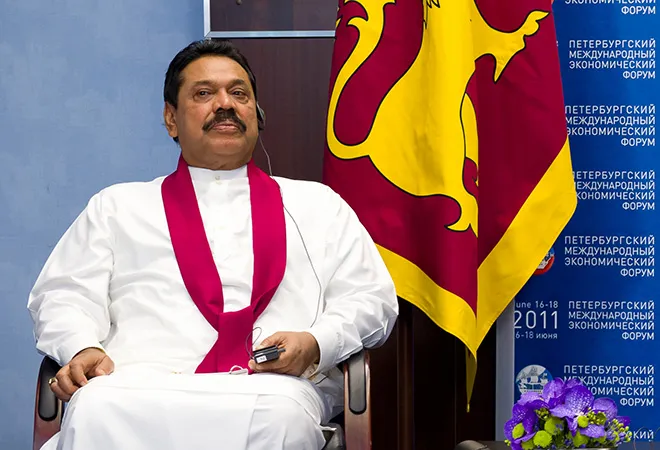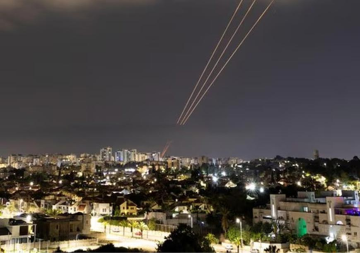
Despite post-poll, anti-India statement from a section of his camp, former Sri Lankan President Mahinda Rajapaksa, now on a return-spree, may still go slow against India, unlike as anticipated by sections in the two countries. On the ethnic front, where India still has a seeming outsider’s stake greater than any other country, Mahinda’s parliamentarian-son Namal lost no time in silencing ‘hard-line’ Sinhala voices on their side, by tweeting in Tamil and accepting the ‘Tamils verdict’ (in the North and the East), stating that they were ‘carefully looking into ways to work even more closely with the Tamil people’.
As ‘ethnic irony’ would still have it, the Rajapaksa-led Sri Lanka Podujana Peramuna (SLPP) has swept the much-delayed, nation-wide local government (LG) polls of 10 February, against a divided government coalition of his parent party, SLFP, led by President Maithiripala Sirisena and the UNP under Prime Minister Ranil Wickremesinghe. In the Tamil areas, the truncated three-party Tamil National Alliance (TNA), down from the original four partners, has continued to dominate the electoral scene but with reduced margins and doubts about its future viability and electoral say.
The majority Sinhala voters have preferred the Rajapaksa kind of political stability to the Maithiri-Ranil duo contribution of unending acrimony and consequent confusion in the government camp. After winning the LG polls, Rajapaksa lost no time in demanding fresh elections to the nation’s Parliament, though a new law may be required for the purpose. The alternative would be for him to encourage wholesale defections, for him to become prime minister, way ahead of the 2020 parliamentary polls.
China factor
Though seen as pro-China when in power, and hence anti-India, Rajapaksa opposed the successor government’s conversion of massive Chinese investments into equity in the controversial Hambantota port project of his days. From the Indian perspective, it will be interesting to see if and now he is equally serious about re-conversion of the equity into loan, and if there are legal and fiscal possibilities for the same – or, at least in demanding the same, now that he has greater political voice than earlier.
It is not very well known, even less acknowledged, in India that the Rajapaksas in particular and the Sri Lankan State otherwise has invariably differentiated among bilateral issues and concerns, including the ethnic issue. On China thus, successive leaders have said, or proved that they would still accept investments for creating jobs and incomes from whichever side it came, but on ‘external and geo-strategic security’, they would not want extra-regional players – be it China, or even the US, or whoever. Their shared preference is India.
If, however, Rajapaksa could not but permit possible Chinese request for berthing their submarines in the Colombo port, whatever be the other side’s intent and its content, it may have owed actually to Beijing standing up and working with his Government to try and defeat the UNHRC resolution on ‘war crimes probe’, especially after India had changed tack and voted with the US on the demand for an ‘independent, international probe’. Today, under his successor, self-styled, pro-reforms government, the UNHRC probe, or any probe in its place, is as good as dead -- and India may have to wade carefully, from now on.
Ethnic issue
The advent of the Narendra Modi Government in Delhi has meant that India kept mostly away from Sri Lanka’s ethnic issue – maybe also because the post-Cold War US ally and its western partners were taking even greater interest after UNHRC-2012 and more so after the incumbent government came to power in January 2015. Prior to Modi leadership, the earlier BJP-NDA dispensation under Prime Minister Vajpayee (1998-2004) too had stayed clear of Sri Lanka, as India too was yet to recover from the shock of the Rajiv Gandhi assassination (1991).
It also made diplomatic sense to go slow on the Sri Lankan ethnic issue, as there were one too many players already, and with the confidence that India could not be kept out of any final negotiated settlement, if and when it came to that. In between, the TNA too needed to find its place in the post-war Sri Lankan scheme, and without the LTTE to guide them or threaten them. The fact is that the TNA too has gone as wayward as any other political party in any democracy of the kind, with the result, the LG poll results does now hold some surprises, if not shocks, for the party – both within and outside of the organisation.
One thing seems to be clear just now. The new Sri Lankan Constitution, which was supposed to be the promised panacea for all of Tamils’ ills, is most unlikely to see the light of the day. Rightly or wrongly interpreting the Rajapaksa victory as one for the ‘Sinhala-Buddhist nationalist’ constituency in the South, the Sirisena-Ranil combine would rather distance themselves away from the current efforts.
It was an eye-wash from the beginning, for which the TNA fell for from the very beginning, and for no explicable reason other than the Diaspora Tamils’ poll-time hatred especially against President Rajapaksa after the armed forces had neutralised the LTTE so very completely. The case of ‘missing persons’ and ‘war crimes’ needed probing even if to clear the armed forces of any culpability or sin, but neither has moved an inch, whichever way.
For the ‘day after’
China and ethnic issue apart, even the bilateral CEPA/ETCA has not moved an inch after President Rajapaksa stalled its signature at the Colombo SAARC Summit in November 2008. In the post-LG polls context, Udaya Gammanpilla, leader of the Pivithru Hela Peramuna (PHU), a minor partner in the Rajapaksa-centred ‘Joint Opposition’, with his SLPP at the centre, went out of the way to the unfinished CEPA/ETCA agreement with India. It remains to be seen if post-poll anti-India rhetoric of allies had his approval, leave alone blessings.
But then Rajapaksa has since showed up Sri Lanka’s map at a news conference, showing how the ‘Eelam area’ has shrunk after the LG polls, and how his ‘kurukkan’ (maroon colour of millet, which the family had adopted for their satta, or shawl, from their father’s time) dominated the nation. If it was a message, it was confined to internal ethnic issue, not extending to India, but in the current round, if he came up to discussing and resolving the same, he too might want to confine it as a ‘domestic issue’, as against the TNA’s continual demand for keeping it ‘international’ still. For his part, TNA leader R Sampanthan, after the party’s near-wholesale victory across the Tamil North, but with signs of rival actors making a pitch, too has lost no time in appealing to Mahinda R, for the latter to join hands in resolving the ethnic issue.
Un-verified, un-tested
India would still be watching the current Sri Lankan situation carefully, without making more assumptions of the earlier kind. It is now becoming clear that the Indian strategy for a post-Rajapaksa political dispensation in Sri Lanka, and the incumbent duo’s ability to deliver on the ethnic issue or the China factor may have been un-verified even while it could not have been tested. It is becoming increasingly clear that on all these counts, India, like its post-Cold War US partner in geo-strategic, Indian Ocean affairs, seems to have not thought of or for the ‘day after’ when it made its moves through the past years and post-war decade in Sri Lanka.
Prime Minister Modi had gone out of the way to wish Rajapaksa victory from the podium of the Kathmandu SAARC Summit in end-2014, only weeks ahead of his losing the presidential polls in early 2015. Not long after the polls, Rajapaksa told an Indian journalist in a published interview that Indian agencies had worked with their US and other western counterparts to have him defeated. Though he went slow afterward, his camp may not have also forgotten how former Indian Prime Minister Manmohan Singh stayed away from the 2013 Commonwealth Summit in Colombo, after keeping the Sri Lankan organisers hopeful yet on tender-hooks until the last minute.
Yet, there is a breather of sorts for India, as the Rajapaksa victory now is only in the local government elections, not one to regime-changing presidential and/or parliamentary polls, coming as it did at a time the Indian leadership was busy with common neighbour Maldives and other extended neighbourhood of Palestine and West Asia, among others. India can expect Sri Lanka to be engaging itself even more domestically on demands for and manipulations over regime-change, fresh elections, et al, with its impact felt closely on the ethnic issue, for instance, but not necessarily on the China factor, least of all on bilateral trade arrangements of the CEPA/ETCA kind.
The views expressed above belong to the author(s). ORF research and analyses now available on Telegram! Click here to access our curated content — blogs, longforms and interviews.




 PREV
PREV


